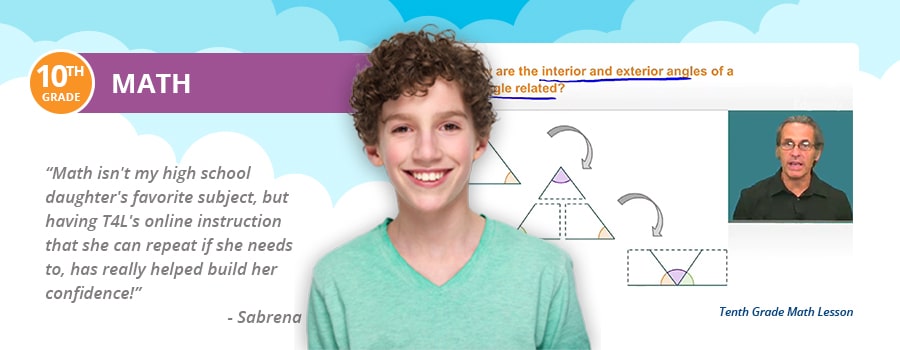10th Grade Math Curriculum
It is fairly common for 10th grade math students to study Geometry during this year. However, home education allows families to set their own math curriculum, determine progression and sequencing of math courses.
If you have questions regarding what math a 10th grader should know and how Time4Learning’s 10th grade math curriculum fits the requirements of your child’s sophomore year, please review the following information.
What Math Should a 10th Grader Know?
10th grade math lessons should build on previous knowledge. If your student has already learned Algebra I (or Pre-Algebra for remedial students), then they can now expand their skills in applying geometric concepts based on plane Euclidean geometry. They can also move on to Algebra II if they prefer, and take Geometry later. It is entirely up to your student’s preference and aptitude.
Honing these skills will help your child improve their working knowledge of more difficult strategies and concepts, which will make achieving success in their junior and senior years a realistic goal.
Some things a tenth grade math curriculum should focus on include:
- Identifying and naming undefined terms of point, line, plane, and distance along a line.
- Completing the steps to prove that the medians of a triangle meet at a point.
- Finding the coordinates of the vertices of an image or pre-image of a dilated polygon given the scale factor.
- Solving problems involving segments formed by two intersecting tangents.
- Calculating the length of the apothem of a regular polygon.
- Use permutations to compute probabilities of compound events.
Learn more about Time4Learning’s tenth grade math lesson plans.
Math Objectives for 10th Grade
The following is a typical list of objectives that a tenth grader should meet by then end of their sophomore year:
- Analyze descriptions and diagrams that illustrate basic postulates about points, lines, and planes.
- Complete the steps to prove angle relationships given parallel lines cut by a transversal.
- Complete the steps to prove theorems involving similar triangles.
- Classify and describe relationships within the family of quadrilaterals.
- Decompose composite 2-D figures.
- Represent and interpret the union and intersection of sets using set notation and Venn diagrams.
Time4Learning’s 10th Grade Math Lesson Plans
- Euclidean Geometry
- Defining Terms
- Measuring Length and Angles
- Introduction to Proof
- Linear Pairs and Vertical Angles
- Complementary and Supplementary Angles
- Performance Task: Constructions
- Introduction to Transformations
- Reflections
- Translations
- Rotations
- Compositions
- Symmetry
- Parallel and Perpendicular Lines
- Lines Cut by a Transversal
- Proving Lines Parallel
- Slopes of Parallel and Perpendicular Lines
- Writing Linear Equations
- Triangle Angle Theorems
- Triangles and Their Side Lengths
- Triangle Inequalities
- Isosceles Triangles
- Centroid and Orthocenter
- Incenter and Circumcenter
- Congruent Figures
- Triangle Congruence: SAS
- Triangle Congruence: ASA and AAS
- Triangle Congruence: SSS and HL
- Using Triangle Congruence Theorems
- Performance Task: Congruency Proofs
- Dilations
- Similar Figures
- Triangle Similarity: AA
- Triangle Similarity: SSS and SAS
- Using Triangle Similarity Theorems
- Right Triangle Similarity
- Directed Line Segments and Modeling
- Cumulative Exam
- Triangle Classification Theorems
- Special Right Triangles
- Trigonometric Ratios
- Solving for Side Lengths of Right Triangles
- Solving for Angle Measures of Right Triangles
- Law of Sines
- Law of Cosines
- Area and Perimeter of Triangles
- Classifying Quadrilaterals
- Parallelograms
- Proving a Quadrilateral is a Parallelogram
- Special Parallelograms
- Trapezoids and Kites
- Figures in the Coordinate Plane
- Introduction to Circles
- Central Angles
- Inscribed Angles
- Secants, Tangents, and Angles
- Special Segments
- Circumference and Arc Length
- Area of a Circle and a Sector
- Angle Relationships
- Performance Task: Circle Constructions
- Equation of a Circle
- Parabolas
- Area of Triangles and Parallelograms
- Perimeter and Area of Rhombi, Trapezoids, and Kites
- Angle Measures of Polygons
- Area of Regular Polygons
- Area of Composite Figures
- Density and Design Problems
- Three-Dimensional Figures and Cross Sections
- Volume of Prisms
- Volume of Pyramids
- Volume of Cylinders, Cones, and Spheres
- Cavalieri’s Principle and Volume of Composite Figures
- Sets and Venn Diagrams
- Finding Outcomes
- Theoretical and Experimental Probability
- Independent and Mutually Exclusive Events
- Conditional Probability
- Probability and Two-Way Tables
- Probability with Combinations and Permutations
- Performance Task: Applying Probability Concepts
- Cumulative Exam
Why Choose Time4Learning 10th Grade Math Homeschool Curriculum
Time4Learning’s 10th grade math curriculum not only meets the objectives described above, it delves deep into additional concepts and practices that tenth graders must learn. It also provides parental tools, which make homeschooling easier whether you are new or an experienced homeschooler.
A solid 10th grade math education should provide tons of math practice to ensure mastery of skills before moving on to the next level. Our curriculum builds on previous knowledge and provides plenty of math practice to help students achieve their math goals.







